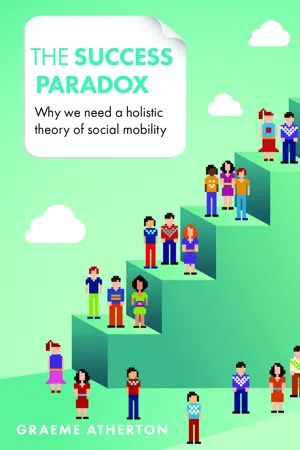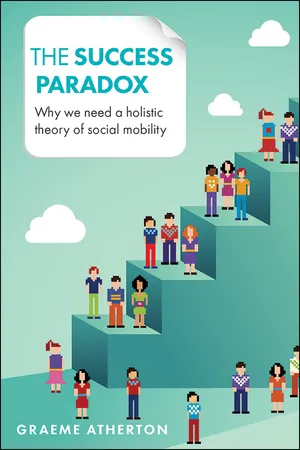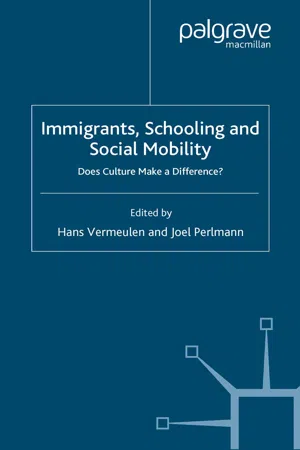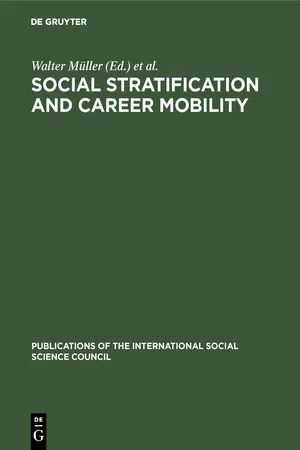Social Sciences
Social Mobility
Social mobility refers to the ability of individuals or groups to move within or between social strata or classes in a society. It encompasses upward or downward movement in terms of wealth, education, occupation, or social status. The concept is central to understanding the dynamics of inequality and opportunity within a society.
Written by Perlego with AI-assistance
Related key terms
1 of 5
11 Key excerpts on "Social Mobility"
- eBook - PDF
Social Mobility and Education in Britain
Research, Politics and Policy
- Erzsébet Bukodi, John H. Goldthorpe(Authors)
- 2018(Publication Date)
- Cambridge University Press(Publisher)
1 | Social Class as the Context of Social Mobility Social Mobility is the movement of individuals over time between different social positions. Insofar as positions are taken to be in some way more or less advantaged, mobility can be characterised as being upward or downward in direction: that is, as being from a less to a more advantaged position or vice versa. To this extent, the understand- ing of Social Mobility in the social sciences is on much the same lines as it is in everyday life. However, where questions arise concerning actual rates, patterns and trends of mobility, and the systematic collection and analysis of relevant data have to be undertaken, it is necessary for social scientists to think about mobility in ways that are conceptually more explicit and precise than those that serve for less demanding purposes. First and foremost, it is essential that the context of mobility – that is, the positions between which mobility is seen as occurring – should be clearly specified. Within the social sciences there are in fact signifi- cant differences in this regard. Sociologists, who, as indicated in the Introduction, have thus far carried out the greater part of research into Social Mobility, tend to focus on mobility between social strata, as characterised, for example, in terms of social class. In contrast, econo- mists, among whom a sustained interest in Social Mobility is, at least in Britain, a relatively recent development, focus on mobility in terms of income – that is, on the mobility of individuals between different levels within the overall income distribution. In this book we will, as sociologists, be concerned primarily with social class mobility: that is, with mobility between different class positions. - eBook - ePub
Creating Economic Growth
Lessons for Europe
- M. Magnani(Author)
- 2014(Publication Date)
- Palgrave Macmillan(Publisher)
When it comes to economic prosperity, however, we see that on economic merits alone, facilitating intergenerational mobility allows society to efficiently and effectively tap the talents, brains, and energy of all people. Realizing this efficiency and effectiveness is an economic feat of great value as it allows nations to develop and deploy human resources for ever-greater returns. As a 2007 OECD Report says, ‘if the degree of intergenerational transmission of disadvantage can be reduced, the aptitudes and abilities of everyone in society are more likely to be used efficiently, thus promoting both growth and equity’ (d’Addio, 2007).Defining Social MobilityBefore we go further, we need to better define Social Mobility as the term is used in different ways. When a society has high levels of Social Mobility, individuals, no matter the circumstances of their birth, can easily, during their lifetimes, move either up or down the social ladder. Rising to and staying within a certain social class depends upon factors other than birth and previous social affiliation. In such a society, on a practical level, nepotism, cronyism, elitism, and other brands of favoritism and privilege fail to convey disproportionate advantage to anyone.To put it in Blanden et al.’s words (2005), ‘The level of . . . mobility in society is seen by many as a measure of the extent of equality of economic opportunity or life chances. It captures the extent to which a person’s circumstances during childhood are reflected in their success in later life, or, on the flip-side, the extent to which individuals can make it by virtue of their own talents, motivation and luck.’ In a society with low Social Mobility, occupational position, income levels, and social status tend to perpetuate themselves down through the generations. As people enter and age in the workforce, they find their position in society is very much the same as that of their parents.Although the fundamental notion of Social Mobility is easy to grasp, let’s clarify our specific use of the term. Traditionally, the distinction has been drawn between intergenerational and intra-generational mobility. The former describes changes in social status from one generation to the next, contrasting the positions in society of parents and children. The latter takes into account shifts in social status during the lifespan of an individual. In this chapter, we focus on intergenerational mobility. - eBook - PDF
The Success Paradox
Why We Need a Holistic Theory of Social Mobility
- Atherton, Graeme(Authors)
- 2016(Publication Date)
- Policy Press(Publisher)
29 TWO Social Mobility: rising, falling or staying the same Introduction For most of those who study Social Mobility, it is interesting because it is a vital part of a bigger picture. For sociologists, it enables them to be able to better understand how society is structured. One of the most important contributions to such sociological research was Erikson and Goldthorpe’s Constant Flux in 1992. This book was a major comparative study of Social Mobility across nine different countries. However, one of the most revealing parts of the book with regard to why Social Mobility should be studied at all is on the very first page: ‘Discussion of social action requires reference to actors who have, in the last analysis, to be recognized as individual men and women: we must as Stinchcombe has put it, see the social structure as being “peopled”’ (Goldthorpe and Erikson 1992: 1). The question is whether sociological research manages this ‘peopling’ successfully or not, or whether it falls back on a preference for the creation and analysis of structures within which people are slotted. This same question also applies to the work of economists. Throughout the different theories outlined in this chapter, how Social Mobility is examined is always a product of a broader set of beliefs or principles within which it is positioned. This applies to sociologists with their adherence to providing macro-level structural explanations of how society works, or economists and their commitment to mathematical modelling as the route to understanding better how scarce resources are allocated. The problem with this approach to Social Mobility is that, as a concept, it is always defined – and thus trapped – within this broader set of principles. Hence, the understanding of what Social Mobility is and its importance is always partial. - eBook - PDF
Management of Success
Singapore Revisited
- Terence Chong(Author)
- 2010(Publication Date)
- ISEAS Publishing(Publisher)
If “origin status” refers to the status of his or her parent, Social Mobility is then known as inter-generational mobility. This chapter will examine empirically both general Social Mobility using aggregate data and inter-generational mobility when data linking generations is available. There is another important dimension of Social Mobility: absolute versus relative mobility. S 218 Management of Success While it is possible to have absolute upward mobility for all, it is impossible to have relative upward mobility for all as the relative upward mobility of a person must be accompanied by the relative downward mobility of another person. Changes in the weights of each relative position in a social ladder give a measure of the changes in the distribution of people in the social ladder, and hence relative Social Mobility is related to inequality in society. Forces affecting Social Mobility, which is dynamic as it is a measure across time, will determine how a static measure of inequality will evolve over time. As Singapore experiences rising trends of inequality, it is all the more important to understand the determinants and trend of Social Mobility in Singapore. If rising inequality is accompanied by increasing upward Social Mobility, could the temporary adverse effect of inequality be offset by the benevolent effect of upward mobility? Is the relation between inequality and upward mobility always positive, or negative? Hence, it is important to understand, theoretically and for policy analysis, that both inequality and Social Mobility are jointly endogenous, influenced by other variables such as structural changes in technology, demography, and government policies in education and the labour market. This chapter will contribute to this understanding by developing a simple demand-supply framework of Social Mobility and inequality, and in particular, wage inequality. - eBook - ePub
The Success Paradox
Why We Need a Holistic Theory of Social Mobility
- Atherton, Graeme, Graeme Atherton(Authors)
- 2016(Publication Date)
- Policy Press(Publisher)
TWO
Social Mobility: rising, falling or staying the same
Introduction
For most of those who study Social Mobility, it is interesting because it is a vital part of a bigger picture. For sociologists, it enables them to be able to better understand how society is structured. One of the most important contributions to such sociological research was Erikson and Goldthorpe’s Constant Flux in 1992. This book was a major comparative study of Social Mobility across nine different countries. However, one of the most revealing parts of the book with regard to why Social Mobility should be studied at all is on the very first page: ‘Discussion of social action requires reference to actors who have, in the last analysis, to be recognized as individual men and women: we must as Stinchcombe has put it, see the social structure as being “peopled”’ (Goldthorpe and Erikson 1992: 1).The question is whether sociological research manages this ‘peopling’ successfully or not, or whether it falls back on a preference for the creation and analysis of structures within which people are slotted. This same question also applies to the work of economists. Throughout the different theories outlined in this chapter, how Social Mobility is examined is always a product of a broader set of beliefs or principles within which it is positioned. This applies to sociologists with their adherence to providing macro-level structural explanations of how society works, or economists and their commitment to mathematical modelling as the route to understanding better how scarce resources are allocated.The problem with this approach to Social Mobility is that, as a concept, it is always defined – and thus trapped – within this broader set of principles. Hence, the understanding of what Social Mobility is and its importance is always partial.Pitirim Sorokin and the meaning of ‘stratification’
The major pre-war sociological contribution to understanding Social Mobility came from the work of Pitirim Sorokin. The way in which Sorokin considered Social Mobility was broader. Less trammelled by the development of an academic discourse in the area (which, as in any area of established academic discourse, can close off debate by setting parameters to discussion), Sorokin was able to consider the meaning of Social Mobility. - eBook - PDF
Moving Up And Out
Poverty, Education & Single Parent Family
- Lori Holyfield(Author)
- 2010(Publication Date)
- Temple University Press(Publisher)
Some we have control over; others we do not. Sociologists assign social class by taking into account a person’s income, occupation, and education. These three conditions, com-bined with race and gender, largely determine our location in the social arrangement of American society. Sociologists also speak of various kinds of social mobil-ity, or the extent to which our social class changes over time. Intergenerational mobility, for example, refers to the degree to which one is better or worse off than one’s par-ents. Intragenerational mobility is the extent to which an in-dividual experiences upward or downward mobility over a Education and Mobility 55 lifetime. Structural mobility is movement upward or down-ward according to large-scale changes in the occupational structure. This type of mobility affects large segments of the population. For example, in the 1980s and 1990s there was significant growth in upper-middle-class jobs, such as in the technology sector. Growth also occurred in the low-skill, low-wage sector, while mid-level jobs shrank in num-ber. 12 This polarized growth suggests a downward trend in structural mobility as the middle rung of the employment ladder narrows. 13 What does this mean for single parents, especially sin-gle mothers? Quite simply, it means that without an edu-cation or substantial training, the best they can hope for are jobs at the bottom of the continuum paying poverty-level wages. These “secondary market” jobs, as they are called, do not offer adequate wages, health care and retire-ment benefits, job security, or opportunities for advance-ment. Whether we experience upward or downward mobility depends upon several factors, but the most important of these is the circumstance of our birth. The socioeconomic status of the family into which we are born is the best pre-dictor of our own status as adults. Sociologists call this phe-nomenon class inheritance. - eBook - PDF
- David Grusky(Author)
- 2019(Publication Date)
- Routledge(Publisher)
Part IV Generating Inequality Social Mobility Classical Viewpoints Modern Analyses of Class Mobility Modern Analyses of Income Mobility and Poverty Spells Status and Income Attainment Basic Models Social Psychological Models The New Structuralism Social Capital, Networks, and Attainment Rational Action Approaches to Mobility and Attainment Social Mobility ..... CLASSICAL VIEWPOINTS PITIRIM A. SOROKIN Social and Cultural Mobility Conception of Social Mobility and Its Forms By Social Mobility is understood any transi-tion of an individual or social object or value-anything that has been created or modified by human activity-from one social position to another. There are two principal types of Social Mobility, horizontal and verti-cal. By horizontal Social Mobility or shifting, is meant the transition of an individual or so-cial object from one social group to another situated on the same level. Transitions of indi-viduals, as from the Baptist to the Methodist religious group, from one citizenship to an-other, from one family (as a husband or wife) to another by divorce and remarriage, from one factory to another in the same occupa-tional status, are all instances of social mobil-ity. So too are transitions of social objects, the radio, automobile, fashion, Communism, Darwin's theory, within the same social stra-tum, as from Iowa to California, or from any one place to another. In all these cases, shift-ing may take place without any noticeable change of the social position of an individual or social object in the vertical direction. By Originally published in 1959. Please see complete source information beginning on page 891. vertical Social Mobility is meant the relations involved in a transition of an individual (or a social object) from one social stratum to an-other. According to the direction of the transi-tion there are two types of vertical social mo-bility: ascending and descending, or social climbing and social sinking. - eBook - PDF
- Ann Denis, Devorah Kalekin-Fishman, Ann Denis, Devorah Kalekin-Fishman(Authors)
- 2009(Publication Date)
- SAGE Publications Ltd(Publisher)
A TURN TO NORMAL SCIENCE An examination of the articles published in the specialized journal Research in Social Stratification and Mobility ( RSSM) 9 allows us to highlight the major shared assumptions of this much focused and very productive field of sociological research. We argue that most articles share a meritocratic per-spective as well as an individualist view of institutional mediations. Again, due to excel-lent available reviews of the field, we will focus mainly on the exceptions to the rule, on the articles that diverge from the mainstream. Meritocratic assumptions Though the Social Mobility paradigm allows for a wide range of ways of describing the social structure and interpreting longitudinal trajectories, most of the articles published in RSSM provide a conventional meritocratic interpretation of Social Mobility: education is the main factor in upward mobility, and occupational positions are the rewards of individual educational achievements. LIFECOURSE OF THE Social Mobility PARADIGM 207 The Social Mobility literature at first trans-lates its interest in longitudinal trajectories into a narrowly focused interest on the bivari-ate relationship between the occupational classes of fathers and sons (and later on of mothers and daughters) (Treiman and Ganzeboom, 2000). It then turns to earnings or income, and to education. Few papers refer to other aspects and determinants of social position such as lifestyles (Sobel, 1983), life experiences through social inter-action, cultural orientations, and political action (Kingston, 1994), patterns of practices involving residential selection, children’s peer groups, volunteer organizations (Kendall, 2006), or region, housing, and cul-tural consumption (Ganzeboom et al., 1990). - eBook - PDF
Immigrants, Schooling and Social Mobility
Does Culture make a Difference?
- H. Vermeulen, J. Perlmann, H. Vermeulen, J. Perlmann(Authors)
- 2000(Publication Date)
- Palgrave Macmillan(Publisher)
This can be seen either as proof that the evil cannot be eradicated and that combating it is like fighting a many-headed dragon, or as evidence that real issues are involved that cannot be addressed by simply ignoring contaminated concepts. 6 Immigrants, Schooling and Social Mobility Patterns of differential Social Mobility in immigrant ethnic groups The study of Social Mobility has been one of the classical themes of sociol- ogy since De Tocqueville, Marx, Weber and Sorokin. 11 Since the 1960s the field has become ever more specialized and technical, and dominated almost entirely by the survey method. At least since the early 1970s, it has also been criticized for attaching greater value to statistical virtuosity than to substantive issues. Social Mobility research has come under attack on other grounds too. Partly because of its over reliance on surveys, it has been criticized for its individualistic bias. It has tended to treat the ran- domly chosen individuals in the survey research as isolates, giving scant attention to their social embeddedness within specific contexts. Related to this, its excessive focus on occupations, and thus on the individuals expected to have those occupations, has resulted in an almost exclusive focus on men. Researchers have tried to accommodate such criticisms in various ways. Qualitative approaches have been adopted to supplement quantitative ones (for example Bertaux and Thompson 1997a), and quanti- tative techniques are being developed to measure contextual effects and avoid the exclusive focus on occupations and the resulting male bias. The contributors to this volume make use of both quantitative and qual- itative methodologies, and they focus on education as well as the labour market. Most put a strong emphasis on comparison. Several compare groups that are similar in at least some respects and have migrated to the same country at about the same time under similar conditions. - eBook - PDF
- Walter Müller, Karl Ulrich Mayer, Walter Müller, Karl Ulrich Mayer(Authors)
- 2019(Publication Date)
- De Gruyter Mouton(Publisher)
By means of this exploratory procedure an evaluation of the extent to which the subjective notion of mobility corresponds to the current sociological conception of this term was to be made. The information collected on perceived changes in the past and on expected future changes should indicate in which terms actual mobility is articulated. The questions concerning aspirations were intended to probe whether respondents also entertain mobility goals different from those that were within the limits of their current life situation. If we take the amount of education received as an important prerequisite of occupational placement, even if it is also in part sought after as a source of satisfaction in itself, and consider income, standard of living and property as benefits largely derived from occupational activity, movements in such a broadly conceived occupational sphere account for the major portion of sub-jectively defined Social Mobility. Only a small part of these responses, how-ever, refer specifically to upward mobility within educational and occupational hierarchies and an even smaller share manifest any status or prestige connota-tions. While only few think of themselves predominantly as being mobile in phy-sical space or in terms of kind or amount of leisure, the great number of res-ponses in the dimension of family affairs deserves attention. Leaving the parental family, marrying and having children are ends to be achieved in a certain age-period and may conflict with educational and occupational goals. These rival orientations of Social Mobility may pose a real value-dilemma be-tween economic and occupational success on the one hand and satisfactory Social stratification and career mobility 109 social relations, emotional and sexual ties on the other which cannot easily be resolved by manipulating the personal time-budget. - eBook - PDF
- Irina Tomescu-Dubrow, Kazimierz M. Slomczynski, Henryk Doma?ski, Joshua Kjerulf Dubrow, Zbigniew Sawi?ski, Dariusz Przybysz, Henryk Doma?ski, Zbigniew Sawi?ski, Henryk Doma?ski, Zbigniew Sawi?ski, Kazimierz M. Słomczyński, Henryk Domański, Zbigniew Sawiński(Authors)
- 2018(Publication Date)
- Central European University Press(Publisher)
Such a tendency was visible in Poland after World War II in some segments of the old Polish intelligentsia. 84 DYNAMICS OF CLASS AND STRATIFICATION IN POLAND Absolute Social Mobility is measured by percentages of individuals moving from categories of origin to categories of destination, while relative mobility refers to the strength of association between these categories. The size of rela-tive mobility used to be captured in terms of “odds ratio,” which indicates how much every two individuals from different categories of social origin differ with respect to their chances of being located in one, rather than the other, of each pair of categories of destination. Since relative mobility is analyzed in terms of odds ratios, it does not depend on distributions of social origin and destination categories, unlike absolute mobility rates, which are affected by them. In esti-mating relative mobility, we need to compare only the chances of different social categories (for absolute mobility, such comparisons are not required). This makes it possible to establish to what extent the observed rate of Social Mobility differs from a hypothetical state of equality of chances, which is “intergroup” in its essence—equality of chances exists when the chances for achieving a given social position are the same for any pair of categories of social origin. Concerning the sociological meaning of absolute and relative Social Mobility, it can be said that the latter refers to social norms “governing” the processes of preserving social positions or moving from one position to another. These norms represent relationships of social, economic, cultural, and political “power” between classes, occupations, and other categories and manifest themselves in the differentiation of social resources that facilitate (or hinder) mobility (or stability) for members of these groups (see Erikson and Goldthorpe 1992; Breen 2004; Domański and Przybysz 2007; Domański and Mach 2008).
Index pages curate the most relevant extracts from our library of academic textbooks. They’ve been created using an in-house natural language model (NLM), each adding context and meaning to key research topics.










